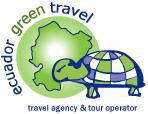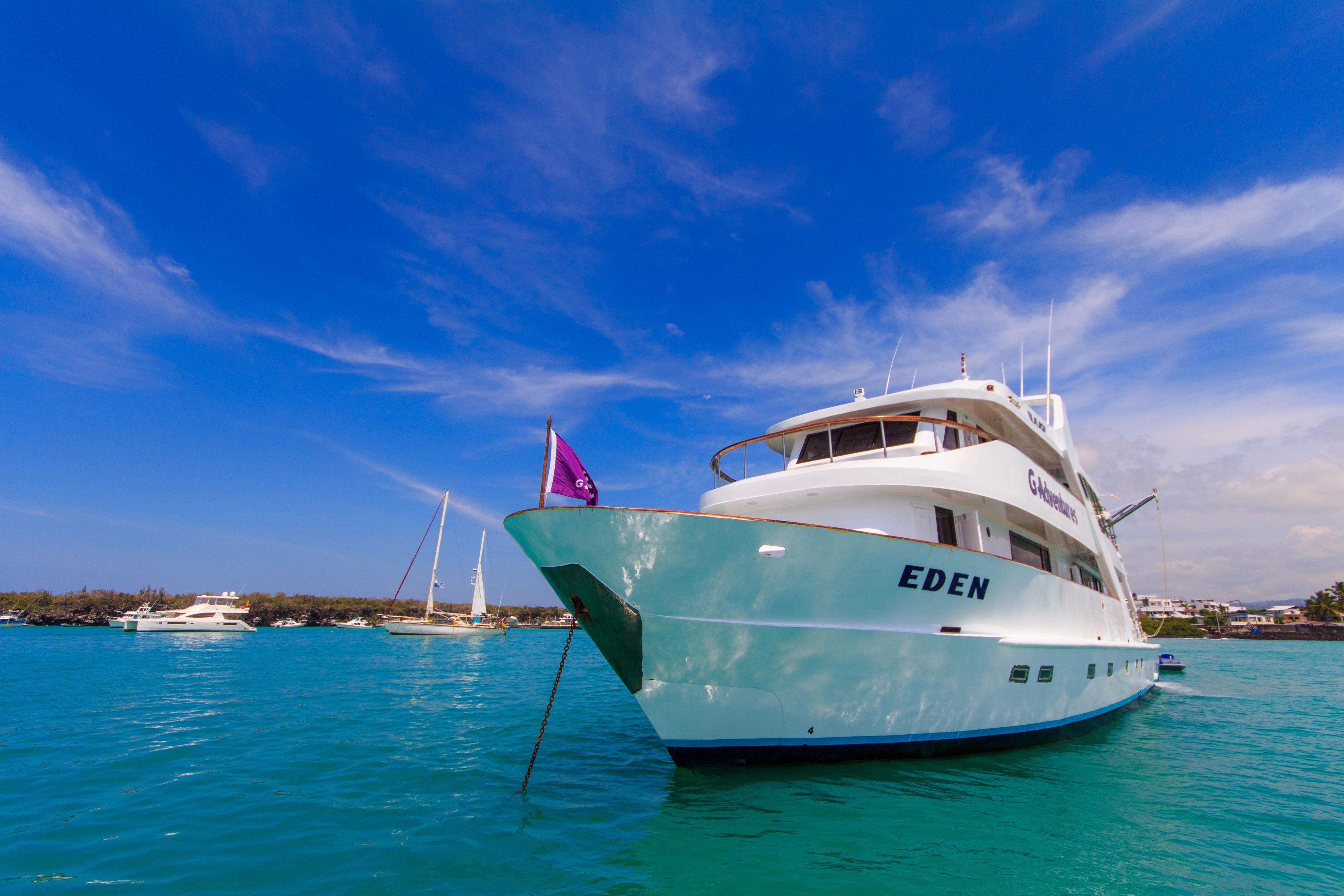DAY 1 - THURSDAY
AM: CRUISE STARTS AT BALTRA AIRPORT (GPS)
Arrival at Baltra Airport and transfer in. You must pay your Galapagos National Park entrance fee (unless it was pre-paid) and your luggage will be inspected. An ONIRIC CRUISES guide will meet you, help you collect your luggage, and escort you on a short bus ride to the harbour. Here you will climb aboard the yacht Tribute. After greeting
the crew and the captain, your cabins will be assigned to you and then you will enjoy your first lunch aboard.
PM: HIGHLANDS (SANTA CRUZ)
Santa Cruz offers excellent opportunities for viewing wild Galapagos giant tortoises, roaming through pastures in the agricultural zone and in the transition zone of adjacent El Chato Tortoise Reserve.

DAY 2 - FRIDAY
AM: TINTORERAS AND SIERRA NEGRA VOLCANO (ISABELA)
While you were sleeping, we navigated to the western island of Isabela, the largest of the archipelago, and one of it’s youngest, at 1 million years old. Your first visit here will be to the offshore islet of Tintoreras, remarkable for its breeding colony of large marine iguanas (each member measures up to 1.5 m/5 ft!).
Snorkelling opportunities are excellent, as the site features a unique tidal channel with clear, turquoise waters, allowing you to swim alongside playful sea lions, marine turtles, marine iguanas, sting rays, and white tip sharks. Also, you have one of the best chances to see the only tropical penguin in the world.
Afterwards, you will enjoy a tour to the Sierra Negra volcano. Bring a backpack with hiking & water shoes, sunglasses, hat, sunscreen and a light rain jacket. Sierra Negra is the only major volcano on Isabela which crater regions are currently open to tourism. Its impressive caldera of 10 km wide is the largest of the Galapagos Islands. The route followed is approximately 16 km long, and will reward you with dramatic geological and ecological contrasts.
You will start today’s tour to Sierra Negra boarding a local chiva-ride (open truck with wooden benches) leading from Puerto Villamil to the National Park Entrance. After crossing a barren lava flow with cacti and passing a flamingo lagoon, the main road leads through Isabela's surprisingly lush agricultural highlands. While gaining altitude, no less than five vegetation zones will be passed.
A trail along the rim of Sierra Negra Volcano leads to a viewpoint where you can try to grasp the incomprehensive dimensions of its caldera (clear weather unpredictable, but thanks to prevailing winds fog usually tend to dissolve on approach). Songbirds will accompany you along the way, harmonizing the steaming volcanic landscapes.
PM: WETLANDS, WALL OF TEARS AND TORTOISE BREEDING CENTRE (ISABELA)
You will disembark the cruise in the afternoon, to explore Black Turtle Cove from the dinghy. This place is a living illustration of how mangroves alter the marine environment to create a rich and unique habitat. Three mangrove species crowd the area from the shore out into the lagoon, which reaches almost a mile inland.
As we drift through quiet waters in the zodiac, you are likely to see spotted eagle rays, which swim in a diamond formation. White-tipped reef sharks slip beneath the boat and Pacific green turtles come to the surface for air.

DAY 3 - SATURDAY
AM: MORENO POINT (ISABELA)
During the night we navigated to the northwest coast of Isabela, where the Sierra Negra and Cerro Azul volcanoes are found. In between these two, we will disembark at Punta Moreno, where a trail that runs along a solidified black lava flow will lead us to a complex of tidal lagoons. In their waters, we might see sharks and marine
turtles. Several species of birds will also be visible, including flamingos, which are found around the lakes and mangroves. This is a favorite excursion as it combines the opportunity to see coastal species with a hike through stunning landscapes.
PM: ESPINOZA POINT (FERNANDINA)
Later, you will visit Espinoza Point,which is Fernandina’s only terrestrial visitors site, and one of the few locations where you will find some bizarre animal species, products of natural selection. The figurehead is the emblematic flightless cormorant that lives exclusively in the remote west of Galapagos, and could be considered as the ‘holy grail of evolution’. This bird lost its ability to fly, but instead became an agile marine hunter. You will also love the almost unworldly views with the dominating cone of Volcán La
Cumbre as a spectacular backdrop. The narrow headland that you walk along is the end of a lava tongue that reached the coast and solidified upon contact with the water.

DAY 4 - SUNDAY
AM: TAGUS COVE (ISABELA)
This morning’s visit starts with a dinghy ride along the island’s cliffs. This will provide you a good chance to spot the endemic Galapagos penguin, the only one of its species to live in the tropics. From the landing dock, it’s a 30-minute hike along the trail to the top of the cliff, from where you can observe the iconic Darwin Lake (pictured).
Look carefully at all the graffiti on the surrounding rocks, they were written by pirates, whalers and buccaneers in past centuries. Back at the coast, you could pick a kayak to explore these paradisiacal coastal environment.
PM: WETLANDS, WALL OF TEARS AND TORTOISE BREEDING CENTRE (ISABELA)
You will disembark the cruise in the afternoon, to explore Black Turtle Cove from the dinghy. This place is a living illustration of how mangroves alter the marine environment to create a rich and unique habitat. Three mangrove species crowd the area from the shore out into the lagoon, which reaches almost a mile inland.
As we drift through quiet waters in the zodiac, you are likely to see spotted eagle rays, which swim in a diamond formation. White-tipped reef sharks slip beneath the boat and Pacific green turtles come to the surface for air.

DAY 5 - MONDAY
AM: PINNACLE ROCK (BARTHOLOMEW)
The beautiful volcanic islet of Bartolomé is among the youngest of the islands and, on a geological scale, was just recently born out of the fire. Although it looks deserted at first sight, Bartholomew offers some of the wildest landscapes and best panoramas of the entire archipelago. To enjoy the postcard view of the idyllic “Pinnacle Bay” you will have to climb the stairs to the viewpoint on top of the island (114 m/375 ft).
Enter a dramatic world of threatening (though extinguished) nearby spatter cones, craters, and lightweight lava droplets that have been spewed out by fiery fountains. The summit trail is also ideal for witnessing how scanty pioneer vegetation, such as lava cactus, struggles to take root in the bare virgin lava fields.
PM: SULLIVAN BAY (SANTIAGO)
The arrival in Sullivan Bay is like a moon landing. The desolate, sprawling fields seem to be out of this planet, therefore this island is very popular among photographers and geologists. The last eruption here occurred in 1897, and covered the bay with Pahoehoe lava flows, which are characterized by smooth, gently undulating, or broadly
hummocky surfaces.
The beach nearby has clear, shallow waters that invite to snorkel, and if you venture to deeper waters, generous marine life can be found (like some Galapagos penguins on the rocks!). Moreover, Pacific green turtles, whitetip reef sharks (careless about humans), Galapagos sea lions, and rays are likely to make an appearance.

DAY 6 - TUESDAY
AM: DRAGON HILL (SANTA CRUZ)
Dragon Hill hosts two key-species that are not too commonly distributed throughout the islands: Galapagos land iguanas and American flamingos. You will climb a hill with giant opuntia cacti where these animals feed and breed. This is a very photogenic spot as well, with breathtaking panoramas over the bay and towards an intriguing steep volcanic spout of red lava that overlooks the area. Dragon Hill has become popular because of its picturesque saline lagoons behind the beach, which contain
minerals, algae and shrimp that attract abundance of seabirds.
PM: VICENTE ROCA POINT (ISABELA)
Whilst having lunch we navigated across the Bolivar Channel for a final visit to Isabela island. While entering a dark cave below a spectacular arch, roaring echoes of the waves will accompany you. Just around the corner, the collapsed amphitheatre of the Ecuador volcano offers an impressive view. The calmer waters of the coves are well-protected against the ocean swell and are a fairly cold, but a great place for snorkelling amongst various species of shark, penguins, puffer fish and even seahorses!

DAY 7 - WEDNESDAY
AM - BACHAS BEACH (BALTRA)
Your last visit is to Bachas. Two conjunct beaches, with soft white sand that makes it a favourite nesting site for sea turtles. There is a small brackish water lagoon behind the first beach, where occasionally it is possible to observe flamingos and other coastal birds, such as black-necked stilts and whimbrels. The second beach is longer, and it
has two old barges that were abandoned during the Second World War, when the USA used this Island as a strategic point to protect the Panama Channel.
Now you will be transferred from Baltra to the dock in Puerto Ayora, transfer to Baltra airport.






















